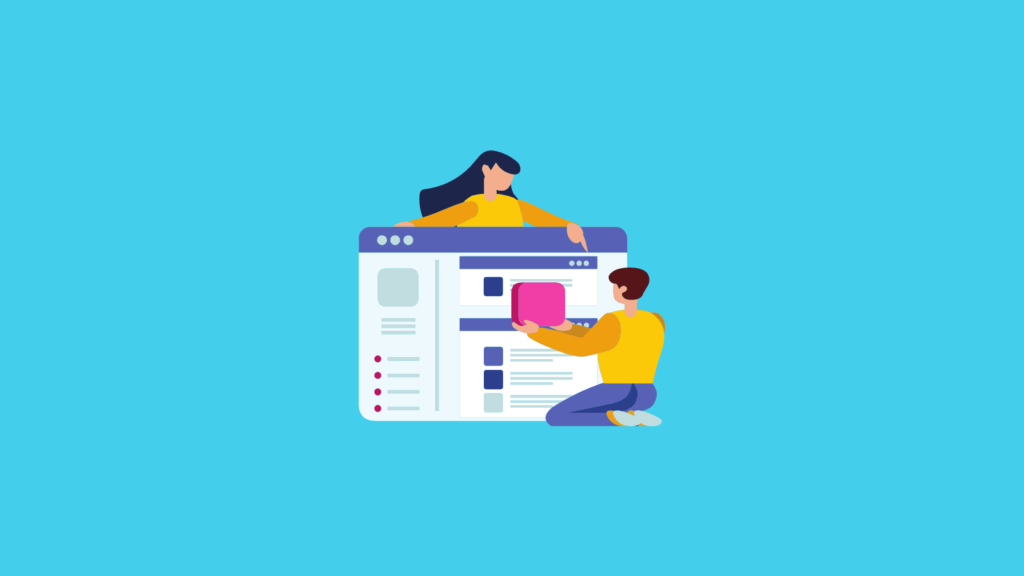What Significance does Web Design have for Your Target Audience?

One of the most crucial components of your brand’s online presence is your website, therefore it’s critical that you design it well. You may also grow your bottom-of-the-funnel leads on your website in order to increase conversions. Therefore, any website errors that can force your prospects to leave your website are something you cannot afford.
Your website should be created with your audience in mind and should guarantee a positive user experience. A decent website design has several additional advantages for your company and your audience.
Chapters
What is Web Development and Design?

Web design and development build user-friendly, aesthetically pleasing, and device-accessible websites and apps. Web design is all about how a website or application looks. The website includes everything, such as typography, colors, images, and pictures.
Web developers are responsible for designing these elements. A web developer will also create a site map for the website or service before launch.
A website or application is initially made to function via web development. Database administration, server setup, programming scripts, and more are all included. Expertise in graphic design is not required for web engineers. But there are companies that can have a large staff, where there are graphic designers and developers. Find your development team or consider this one: https://fireart.studio/hire-dedicated-web-designers/
What Importance Does Web Design Have for the People You Want to Reach?

Initial Impressions Count
The first time a consumer interacts with your brand is often via your website. When a website is well-designed, it creates a positive and lasting first impression. This makes it more likely that visitors will want to explore the site further and engage with the content. Consider using Kubernetes Architecture which can help in the website or software development process.
UX
The user experience is greatly influenced by web design. Visitors can simply explore your website, discover the information they want, and carry out desired activities (such as making a purchase or filling out a form) without difficulty with the help of a user-friendly and intuitive design.
Credibility and Confidence
A sleek and professional website design exudes authority and reliability. Users may think less favorably of your brand if your website seems antiquated or amateurish, which would increase bounce rates and decrease conversions.
Brand Recognition and Identity
Your brand identity is established and strengthened by the web design you choose. Users will find it simpler to identify and remember your brand when you employ consistent branding components, such as colors, typefaces, and pictures.
Mobile Adaptivity
Responsive web design is crucial since the majority of internet users visit websites on mobile devices. By having a design that is mobile-friendly, you can feel assured that your website will appear visually appealing and function correctly on various screen sizes. This will enhance user engagement and satisfaction.
Page Loading Time
Website users anticipate a speedy load time. The speed at which your site loads may be greatly increased by using an optimal design, effective coding, and picture compression. Better user experiences and reduced bounce rates are produced by faster load times.
Accessibility
In order to ensure that your website is accessible to everyone, including those with impairments, it is important to consider web design as a crucial factor. By making sure that your material meets accessibility requirements, you can expand your potential audience and ensure that everyone can access and engage with it.
Placement of the Call-to-Action (CTA)
CTAs are deliberately positioned on websites via effective web design to point people in the direction of the activities you want them to do. Well-designed CTAs enhance conversion rates, whether the action is purchasing something or subscribing to a newsletter.
SEO
SEO and web design go hand in hand. Websites with clear code, responsiveness to mobile devices, and excellent user experience are favored by search engines. Your website will rank better in search engine results and get more organic visitors if it has an SEO-friendly design.
Presentation of Captivating Content
Your material may be better presented online, increasing its impact and engagement. By incorporating visual elements, utilizing space effectively, and choosing the right typography, you can improve your content and make it more engaging and memorable for users.
Conclusion
Web design is not only important for connecting with your audience, but it is also crucial for staying competitive in the digital world. Your website may benefit from web design by developing a distinctive brand presence and gaining a competitive advantage.
FAQ
What is the role of target audience in web design?
The target audience plays a crucial role in shaping the design and content of a website. It helps designers create a site that resonates with the intended users.
How do you identify the target audience for a website?
Target audience identification involves researching demographics, interests, behaviors, and pain points of potential users through surveys, analytics, and market research.
Why is it essential to tailor web design to the specific needs and preferences of the target audience?
Tailoring web design to the target audience ensures that the website meets user expectations, enhances user experience, and increases the likelihood of achieving business goals.
What design elements should be considered when catering to a particular target audience?
Design elements include color schemes, typography, imagery, layout, navigation, and content tone, all of which should align with the preferences and characteristics of the audience.
How can user personas help in web design for a target audience?
User personas are fictional representations of ideal customers. They guide web design decisions by providing a clear picture of the target audience’s goals and behaviors.
What role does responsive design play in catering to diverse target audiences using various devices?
Responsive design ensures that a website functions well and looks appealing across different devices, accommodating the diverse technology preferences of the target audience.
How can web designers address accessibility concerns when designing for a broad target audience?
Web designers can implement accessibility features like alt text for images, proper heading structures, and keyboard navigation to ensure all users, including those with disabilities, can access the site.
How does the content strategy relate to web design for a specific target audience?
Content strategy should align with the target audience’s needs, interests, and preferences. It includes creating relevant, engaging, and valuable content.
Can web designers use analytics and user feedback to refine their designs for the target audience continuously?
Yes, analytics and user feedback help designers track user behavior, identify pain points, and make data-driven design improvements to better serve the target audience.
What are some common mistakes to avoid when designing for a target audience?
Common mistakes include making assumptions about the audience, neglecting mobile optimization, using inappropriate language or imagery, and failing to keep up with changing audience preferences.
How does understanding the target audience’s goals influence web design decisions?
Understanding the audience’s goals helps prioritize website features and content that directly support those objectives.
What impact does cultural sensitivity have on web design for a diverse target audience?
Cultural sensitivity in web design ensures that imagery, language, and symbols used on the site are respectful and inclusive of various cultures and backgrounds.
How can designers create a user-centric navigation system tailored to the target audience’s preferences?
User-centric navigation considers the audience’s browsing habits and preferences, making it easier for users to find information and engage with the website.
What role does storytelling play in web design for capturing the interest of the target audience?
Storytelling through visuals and content can create a compelling narrative that resonates with the target audience, fostering a stronger emotional connection.
How does the page load time affect the user experience for the target audience?
Faster page load times are essential, as a slow-loading website can lead to frustration and high bounce rates, negatively impacting the user experience.
What strategies can web designers employ to ensure that the website’s call-to-action (CTA) resonates with the target audience?
Effective CTAs should use language and design that align with the audience’s needs, guiding them toward desired actions on the site.
How can designers optimize website forms to improve user interactions with the target audience?
Form optimization includes reducing the number of fields, providing clear instructions, and offering user-friendly error messages to enhance form completion rates.
What are some tools and resources available for web designers to research and understand their target audience better?
Tools like Google Analytics, surveys, heatmaps, and user testing are valuable resources for gathering insights into user behavior and preferences.
How can A/B testing help designers make data-driven decisions that cater to the target audience?
A/B testing involves comparing two variations of a design element to determine which one performs better with the target audience, allowing for informed design choices.
In what ways can web designers create personalized experiences for individual segments within the target audience?
Personalization involves using data to tailor content, recommendations, and user interfaces to match the specific needs and interests of different audience segments.
How does the age group of the target audience influence web design decisions?
The age group can impact design choices, including font size, imagery selection, and the overall aesthetic, to resonate with the preferences of different age demographics.
What considerations should be made for the accessibility needs of the target audience when designing a website?
Designers should ensure that the website is compliant with accessibility standards (e.g., WCAG) to accommodate users with disabilities within the target audience.
How can designers create a seamless user journey that aligns with the expectations of the target audience?
A seamless user journey involves designing clear pathways and logical navigation that guide users through the website based on their needs and expectations.
What strategies can be employed to capture and retain the attention of the target audience in the age of short attention spans?
Engaging visuals, concise content, interactive elements, and clear value propositions are effective strategies to capture and retain audience attention.
What is the significance of color psychology in web design for the target audience, and how can it be used effectively?
Color psychology helps evoke specific emotions and associations. Designers use colors strategically to align with the target audience’s feelings and perceptions.
How can designers create mobile-friendly web designs that cater to the on-the-go nature of today’s target audience?
Mobile-friendly design involves responsive layouts, touch-friendly elements, and streamlined content for a seamless mobile user experience.
What impact does the language and tone of website content have on connecting with the target audience?
The language and tone should match the target audience’s communication style, values, and preferences to establish a relatable and trustworthy connection.
How can web designers address the needs of a global target audience with diverse languages and cultures?
Internationalization involves offering multiple language options, culturally sensitive content, and appropriate localization to cater to diverse audiences.
How does social proof, such as customer reviews and testimonials, influence the trust and confidence of the target audience in a website?
Social proof provides credibility and reassurance to the target audience. Displaying positive reviews and testimonials can build trust and confidence.
What role does continuous user research and feedback play in maintaining a website’s relevance to the evolving needs of the target audience?
Ongoing user research and feedback collection allow designers to adapt and make improvements based on changing preferences and user behavior within the target audience.
Create more and better content
Check out the following resources and Grow!